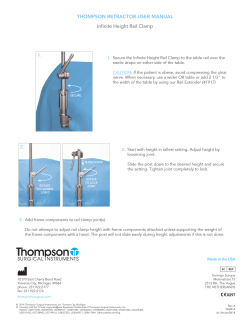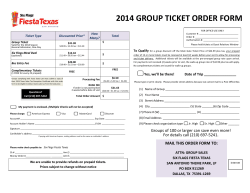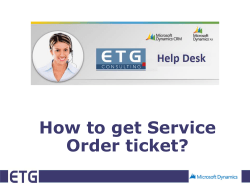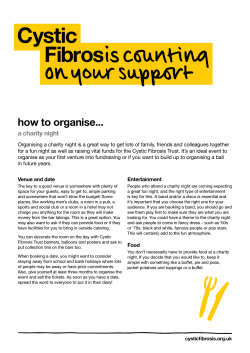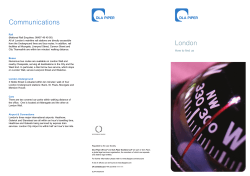
UK Rail with Rail Europe Overview Travel by Train! Enjoy Europe
UK Rail with Rail Europe Overview Enjoy Europe 1 Travel by Train! Summary UK Rail : Recent background, facts and figures The TOCs network Selling UK Rail : services and fares structure 2 UK Rail : Recent background, facts and figures 3 UK Rail – Recent Background Until 1992 • A public system with British Rail, the public, monopolistic rail operator since 1948 In 1993, promulgation of the Railways Act • • Privatisation of British Rail set in motion by John Major's Conservative government Re-organisation of the rail network : the establishment of a single infrastructure management company (Railtrack, subsequently Network Rail) in 1994; and the letting of 24 regional train operating franchises of varying durations from 1996 onwards to service the passenger market. The franchise network was completed in 1997 : • 4 The franchise network was completed in 1997. Franchises are subject to review and re-award after a defined number of years, which differs across franchises. UK Rail – Facts & Figures The UK rail network is the fastest growing railway in Europe, with passenger growth in excess of 50% since the franchise network was completed in 1997 15,795 route kilometers An Extensive and Accessible 2,500 stations Railway Network 44% of population live within 25 minutes walk of a station 1.27 billion passengers in 2008/09 Passenger Demand at 3.5 million passengers per day in 2008/09 Post-War Record Levels 20,000 trains per day 50+% growth in journeys since 1997/98 104 million long-distance rail journeys made in 2007/08 vs 25 million domestic air journeys £5 billion invested in new rolling stock since 1996 Massive Investment & Average age of fleet less than 15 years Improvement Programmes More than £30 billion invested in infrastructure since 1995/96 Passenger rail contributes 0.5% of total UK CO2 emissions (vs 13.4% for road passenger transport) Low Environmental Impact 5 Average CO2 emissions per passenger mile significantly lower than those for short-haul air, car and bus transport UK Rail Organisation The Railway Act establish a new regulatory framework to oversee the activities of and relationships between the various stakeholders Department for Transport Passenger Focus funding Also: Passenger Transport Executives, Welsh Assembly, Transport Scotland, Transport for London Franchise Agreements TOCs ATOC 6 Office of Rail Regulation Track Access Agreement High Level Output Statement Network Rail UK Railway Organization Office of Rail Regulation (ORR) : • • • Regulates Network Rail’s stewardship of the network Licenses the operators of railway assets and approves agreements and charges for access to the network Following the enactment of the Railways Act 2005, ORR has also taken over the safety regulation role of the industry Network Rail : • • Owns, maintains and develops the railway infrastructure, including its track, signaling, electrification equipment and structures (bridges/tunnels/level crossings) Successor organisation to original infrastructure manager, Railtrack Train Operating Companies (TOCs) : • • 7 Manage the provision of day-to-day train services and champion passengers’ interests They provide and run train services and the majority of railway stations ATOC ATOC • • • It stands for “Association of Train Operating Companies” It’s an unincorporated association owned by its members, set up in 1994 by the Train Operating Companies (TOC) formed during privatisation of the railways under the Railways Act 1993. It’s a body which represents around 24 train operating companies that provide passenger railway services on the privatised British railway system As the “official voice of the passenger rail industry”, ATOC • • • • 8 Coordinates of joint activities for its members (TOCs) Manages & promotes of the National Rail brand Provides support services to travel agents In particular, on the international markets ATOC is in charge of the distribution, promotion and marketing of the TOC Sales. International Markets Specificities Until 2009 the only British product line to be sold on the international market was the BritRail one, distributed by ACP : • • Britrail Passes BritRail OT (zoned priced) As of now, the domestic fare range can be sold on international markets and Rail Europe is one of the 3 accredited distributors of this range in its markets. The domestic fare range is the same as the range offered in UK (with a few exceptions : season tickets and discounted cards) and offers much more competitive prices. 9 The TOCs Network 10 Travel by Rail in the UK 15,795 kilometres of track that connect most towns of any size in mainland Britain. London is the hub of the rail network where there are 14 ‘terminals, from which the principal lines that link London with other parts of Great Britain run. However, more and more companies are offering cross-country routes that means travellers can make a variety of journeys without having to cross London. If travellers do have to change trains in London there are a number of options for travelling around: these include London Underground services, buses and taxis. There are also a lot of ‘metro’ systems such as the Newcastle Metro, Glasgow Underground and Docklands Light Railway (DLR) in London, and modern tram systems such as those in Sheffield, Manchester, Birmingham, Croydon and Nottingham. Northern Ireland has its own rail system – Northern Ireland Railways (NIR) has four main routes, radiating from Belfast which serve a number of major cities and towns and some coastal regions. It provides connections with UK ferry services in Belfast and Larne, with airline services at Belfast City Airport. Finally, there is the Eurostar (passenger only) and Eurotunnel (vehicle with passenger) services through the Channel Tunnel. Eurostar services operate from London St Pancras International and Ashford International stations to Paris, Lille, Brussels and other destinations. 11 UK National Rail Network 12 Train Operating Companies 24 train companies that serve the length and breadth of the UK The TOCs operate under a license There are divided in 3 categories : • 9 TOC operate long distance traffic • 6 TOC operate regional traffic • 9 TOC operate London & Southeast traffic 13 Long Distance Traffic 14 Regional Traffic 15 London & Southeast Traffic 16 Selling UK Rail : Services and fares structure 17 Services Train Companies run many different types of trains across the rail network, offering a range of facilities. All trains are totally non-smoking and offer standard seating. Some trains offer additional facilities such as: • • • First Class seating Catering Seat reservations 1st class Anytime tickets provide access to Lounges. WiFi and power points for laptops and mobile phone chargers are available on some trains. Modern trains are equipped with visual information displays and automatic announcements are made to keep you informed throughout your journey. 18 Station Facilities Station facilities in the UK vary but below are a range of facilities that can be found at many of the major terminals: • • • • • • • • • 19 Pay Phone Tourist Information Office ATM Bureau de Change Shops Public WiFi Trolleys Showers First Class Lounge Waiting Rooms Baby Changing Wheelchair-accessible Toilets Toilets Seating Area Information kiosk Help Point Customer Information System Web Kiosk Selling Tickets The full range of fare will be available with Rail Europe The main exception to this is “Season Tickets” which are only available for sale via TOCs, and discounted cards 20 Domestic fare range overview Main benefits • • • Local Fare Range, no more zone pricing More competitive than the former BritRail Open ticket Pass products still available in BritRail range Mains limits • • • • 8 travelers max No groups booking No Senior or Youth fares, in this case a railcard is required and can only be purchased locally No Pass holders fares Good to know • • 21 From a technical point of view, Euronet will be connected to the TOC’s distribution system through Evolvi Evolvi is a technology provider accredited by ATOC Summary of fares types In the past • Over the years, individual TOCs have introduced their own fares, or used different names to describe generic fare types... • As a result, the fare structure was complex, there were many fares on offer, which was a source of confusion for rail customers. The fare simplification took place in 2008, terms and conditions applicable to each fare type were standardized, all across TOCs. There are now just 3 types of fare making it simple. All the train companies now use the same 3 names to only offer the same 3 types of ticket : • Advance • Anytime • Off-Peak 22 Advance: buy in advance, save money ADVANCE = cheap, inflexible... 23 What Single (one-way) tickets for selected journeys Available in First Class and Standard Class Best available price for each journey Possibility to mix and match Advance fares for a return journey When /Validity Only valid on the date and train shown on the ticket Availability Tickets must be purchased in advance of travel, from 12 weeks to the day before travel. Sold in limited numbers, subject to availability Conditions of use /service First Class Advance tickets do not always grant access to First Class Lounges at stations Break of journey Not possible to start, break and resume, or end the journey at any intermediate station except to change to/from connecting trains as shown on the ticket(s) Exchange Possibility to change to time or date of travel before departure of the first reserved train Origin, destination , Train Company and route must remain the same. Difference between the price paid and cost of the next suitable fare is payable, plus a £10 administration fee per person, per single ticket for each change to a journey. If a cheaper fare is available, the difference will not be refunded. Refunds Non-refundable Anytime : buy anytime, travel anytime ANYTIME = fully-flexible... 24 What Fully flexible tickets, with no time restrictions on when you can travel. When /Validity Anytime Single (One Way) and Anytime Day (Single and Return) tickets must be used on the date shown on your ticket. Anytime Single tickets : valid for travel on any train on the date shown on the ticket. Anytime Return tickets : the outward journey must be made within 5 days, and including, of the date shown on the ticket, and return journeys must be made within one calendar month Availability Possibility to buy Anytime tickets in advance or immediately before travel Possibility to get on the train without a reservation. Conditions of use /service The outward part of an Anytime Return ticket is only valid for travel when accompanied by an unused return part of the same ticket First Class Anytime tickets provide access to First Class Lounges at stations Break of journey Possibility to start, break and resume, or end the journey at any intermediate station along the route of travel (with conditions) Exchange Possibility to change : no restrictions on when you can travel, as long as the journey is completed within a calendar month for 'Anytime' tickets and on the date shown on the ticket for 'Anytime Day' tickets. Need to buy a new ticket and apply for a refund on the existing ticket in order to change the date of the single ticket or outward travel (for a return ticket), the route, or to downgrade from First Class to Standard class accommodation Possibility to upgrade the ticket upon payment of an excess fare, if continuing the journey to a further station, or upgrading to First Class Refunds Return unused ticket Rail Europe within 28 days of expiry date, Administration/Cancelation fee will apply. Refund amount takes into account any use of the ticket and in some circumstances no refund will be paid Off-Peak : buy anytime, travel off-peak OFF-PEAK = flexible with restrictions... What Cheaper tickets for travelling on trains that are less busy. Super Off-Peak is the cheaper Off-Peak fare with more restrictions, where is more than one Off-Peak fare for a journey. When /Validity Requirement to travel at specific times of day, days of the week or on a specific route. Generally, not valid on trains leaving London between 15:00 and 19:00 Monday-Friday, and on trains leaving before about 10:30 on Monday-Fridays. Off-Peak Single (One Way) and Off-Peak Day (Single and Return) tickets must be used on the date shown on the ticket and until 0230 on the following day. Off-Peak Return tickets : outward journeys must be made on the date shown on your ticket and return journeys must be made within one calendar month. Availability Possibility to buy Off-Peak tickets in advance or immediately before travel. Possibility to get on the train without a reservation Conditions of use /service The outward part of a Off-Peak Day and Super Off-Peak Day Return ticket is only valid for travel when accompanied by an unused return part of the same ticket. First Class Off-Peak tickets may provide access to First Class Lounges at stations. Break of journey Exchange Refunds 25 Possibility to start, break and resume, or end the journey at any intermediate station on the return leg (but not on the outward leg) along the route of travel, unless the ticket restriction for the journey does not allow it. No need to travel on a specific train, but restrictions on the travel time Check at the station before travelling: you may find you don't need to pay an additional fare as long as your outward travel date remains the same. Off-Peak Day and the outward part of Off Peak tickets are only valid on the date shown on the ticket. Need to cancel and buy a new one if case of changing this date. Return unused ticket within 28 days of expiry date, administration/cancelation fee will apply. Refund amount takes into account any use of the ticket, in some cases refund won’t be paid. Retrieving Tickets (1) All UK Rail tickets are issued as e-tickets / TOD Travelers will need to go to a station with a TVM (Travel Vending Machine) also called FastTicket or a ticket window in a station There are 900 Stations with TOD, 400 have TVM The list of stations will be available on the extranet shortly 26 Retrieving Tickets (2) To collect the ticket, it’s recommended to arrive at the station at least 20 minutes prior to departure Customers must have a credit/ debit card plus their confirmation email containing their reference number (PNR). The Ticket Vending Machine doesn't debit the card but matches the name against the name used for the booking and if the two match, it will print the tickets. Follow steps on screen of the TVM 27 Seat assignation Where applicable, travellers must travel in the Class and reserved seat(s) shown on the ticket(s) Travellers can reserve a seat on many longer distance services and reservations are recommended on busy services When making a reservation, travellers can request the following: a window seat or an aisle seat 28 Tips If the ‘Route’ also states ‘and Connections’, travel is allowed on appropriate connecting trains where shown on the ticket(s) or other valid travel itinerary. If the route shown on the ticket has a †, the ticket includes the cost of travelling between certain London Stations (e.g. between Liverpool St and Paddington) by either London Underground, Docklands Light Railway (DLR) or First Capital Connect (Thameslink Route) services appropriate to the route of the journey being made. Note: Tickets will only be accepted by London Underground and DLR on the date shown on the ticket (or last day of validity for return portions of Off-Peak Returns) and until 0429 the following day. - Other than to change trains, a break of journey at intermediate London Underground or DLR stations is NOT permitted.- Travel restrictions do not apply on weekends and public holidays. 29 Appendices Department for Transport Passenger Focus funding Also: Passenger Transport Executives, Welsh Assembly, Transport Scotland, Transport for London Franchise Agreements Explanation of diagram slide 6 TOCs Office of Rail Regulation High Level Output Statement Track Access Agreement Network Rail ATOC Train Operating Companies (TOCs) Department for Transport (DfT) Manage the provision of day-to-day train services and champion passengers’ interests. They provide and run train services and the majority of railway stations Sets industry strategy, determines overall funding, awards franchises Owns, maintains and develops the railway infrastructure, including its track, signalling, electrification equipment and structures Network Rail (bridges/tunnels/level crossings). Successor organisation to original infrastructure manager, Railtrack Regulates Network Rail’s stewardship of the network, licenses the operators of railway assets and approves agreements and charges for access to the network. Following the enactment of the Railways Act 2005, ORR has also taken over the safety Office of Rail Regulation (ORR) regulation role of the industry Passenger Focus Independent public body, funded by the DfT, set up to protect the interests of rail passengers Facilitation, helping members to work together to meet their obligations and to promote the use of passenger services Assisting members to co-operate on developing products and managing projects that benefit passengers, to promote the advantages of the rail network, and to share best practice ATOC Communicating with government, public bodies, European institutions and other authorities and media, as well as with third parties, including other transport operators Providing information through printed and electronic materials, conferences, meetings and seminars on passenger rail industry issues and collecting, analysing and circulating relevant data 30 and TFL-operated services (with the exception of London Overground) are not members of ATOC Established as a single point of contact for phone enquiries in 1996 National Rail Enquiries Web and other self-service channels (PDA, WAP, SMS) now account for 90% of contacts (NRE) Principal tools are online Journey Planner, live departure boards and information on service disruption/engineering works Glossary Break of journey: Alighting a train and exiting the station at an intermediate stop Conditions of Carriage: The contract that passengers enter into with Train Operating Companies when they buy a ticket CoP: Code of Practice for Ticket on Departure transactions CTR: Customer Transaction Record – a customer’s Ticket on Departure reference E-ticketing: Rail ticket-less travel Eurostar: High speed train service directly from London St Pancras International to the centre of European cities such as Paris and Brussels Evolvi: The brand name of a ticket issuing system accredited for travel agent use FastTicket: Is the brand name of a national network of Ticket on Departure (ToD) machines. Interchange Stations: A station where you can catch a connecting train Metro: A local public rail transportation system, a subway system Network: Any railway line, a collective term for the Industry as a whole. Network Rail: An organisation responsible for running, maintaining and developing Britain’s tracks, signalling system, rail bridges, tunnels, level crossings, viaducts and 17 key stations NR: Network Rail (RFF UK) NRE: National Rail Enquiries NRS: National Rail Standards (for timetable, reservations…) TFL: Transport for London TIS: Ticket issuing systems: accreditation from RSP (Rail Settlement Plan) TOC: Train Operating Company TOD: Ticket on Departure. A facility which allows clients to collect pre-paid tickets from Ticket Vending machines and Booking Offices TVM: Ticket Vending Machine 31
© Copyright 2025

